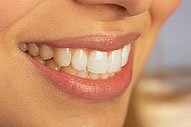People choose esthetic dental procedures/surgery for various reasons—to repair a defect such as a malformed bite or crooked teeth, treat an injury, or just improve their overall appearance. Whatever the reason, the ultimate goal is to restore a beautiful smile.

For these and many other reasons, esthetic dentistry has become a vital and important part of the dental profession.
Common esthetic dental procedures can be performed to correct misshaped, discolored, chipped or missing teeth. They also can be used to change the overall shape of teeth—from teeth that are too long or short, have gaps, or simply need to be reshaped.
Some of the more common procedures involve:
- Bonding – A procedure in which tooth-colored material is used to close gaps or change tooth color.
- Contouring and reshaping – A procedure that straightens crooked, chipped, cracked or overlapping teeth.
- Veneers – A procedure in which ultra-thin coatings are placed over the front teeth. Veneers can change the color or shape of your teeth. For example, veneers have been used to correct unevenly spaced, crooked, chipped, oddly shaped or discolored teeth.
- Whitening and bleaching – As the term implies, whitening and bleaching, a rapidly increasing procedure, are used to make teeth whiter.
Which techniques should be used to improve your smile? A dental exam will take many factors into consideration, including your overall oral health.
-
Chipped, Cracked, and Worn Teeth
Special thin laminates, called veneers, can often be used to correct discolored, worn down, cracked and chipped teeth. Veneers can also be used to close unsightly gaps between teeth. Stronger types of veneers made of porcelain, also called composite veneers, typically last longer because they are bonded to the tooth. Another process called bonding can…
-
Bleaching
Bleaching and non-bleaching products are the two basic kinds of whitening products available today. Non-bleaching products normally use abrasives or chemicals and only remove surface stains on teeth. Bleaching products work with a chemical called peroxide and can brighten your teeth several shades. Another process employs the use of a special gel that is placed…
-
Excessive or Uneven Gums
Many people inherit the problem of excessive or uneven gums. An aesthetic surgical procedure called a gum lift can be used to correct this problem.
-
Dental Bonding
Bonding is a process in which an enamel-like material is applied to a tooth`s surface, sculpted to an ideal shape, hardened, and then polished for an ideal smile. This procedure usually can be accomplished in a single visit. Bonding is often performed in order to fill in gaps or change the color of your teeth.…
-
Teeth Whitening
Whitening procedures have effectively restored the smile of people with stained, dull, or discolored teeth. The darker tissue of your teeth, the dentin, can become exposed as the outer layer of enamel is worn away by the effects of aging or things like caffeine and tobacco. Food particles are naturally attracted to a tooth’s enamel…
-
Old and Unsightly Fillings
Newer kinds of fillings made from composite resins and porcelain can restore unsightly fillings; many people are surprised how natural these kinds of filling materials can make a tooth once covered by the old-fashioned silver amalgams.
-
Grafts
Soft tissue grafts are sometimes performed to treat gum disease, or correct other abnormalities. The procedure involves taking gum tissue from the palate or another donor source to cover an exposed root in order to even the gum line and reduce sensitivity. Periodontal procedures are available to stop further dental problems and gum recession, and…
-
Implants
Before development of dental implants, dentures were the only alternative to replacing a missing tooth or teeth. Implants are synthetic structures that are placed in the area of the tooth normally occupied by the root. Implants are anchored to the jawbone or metal framework on the bone and act as a foundation for an artificial…
-
Ridge Augmentation
If you lose one or more permanent teeth, an indentation may result in the gums and jawbone where the tooth used to be. When no longer holding a tooth in place, the jawbone recedes and the resulting indentation looks unnatural. Ridge augmentation is a procedure that can recapture the natural contour of the gums and…
-
Veneers
Teeth that are badly stained, shaped or crooked may be improved by a veneer placed on the surface of the affected teeth. Veneers are thin pieces of porcelain or plastic cemented over the front of your teeth to change their color or shape. Veneers are used on teeth with uneven surfaces or are chipped, discolored,…
-
Cosmetic Dentistry – Overview
People choose esthetic dental procedures/surgery for various reasons—to repair a defect such as a malformed bite or crooked teeth, treat an injury, or just improve their overall appearance. Whatever the reason, the ultimate goal is to restore a beautiful smile. For these and many other reasons, esthetic dentistry has become a vital and important part…




